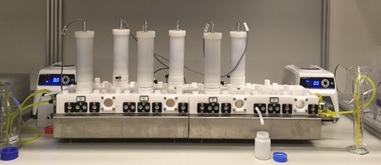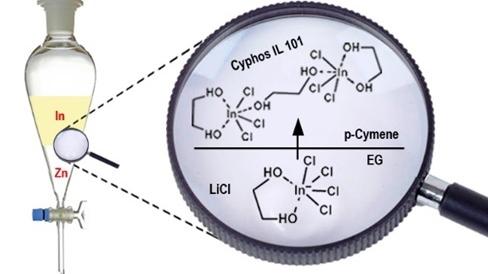SOLVOMET/SIM² KU Leuven researchers developed a novel solvometallurgical approach to extract indium from an ethylene glycol feed solution by the ionic liquid Cyphos IL 101. The extraction and scrubbing processes were performed in lab-scale mixer–settlers to test the feasibility of working in continuous mode. This work was published in the journal RSC Advances.
Indium
Indium is a rare metal that is labeled as a critical raw material by the European Commission, due to its high supply risk. It is produced mainly as a side product of the zinc industry.
Small amounts of indium are produced by processing of copper, tin and lead ores. Indium can also be recycled from secondary indium sources such as production scrap and end-of-life consumer goods.
It is mainly used in high-tech applications such as liquid crystal display (LCD) screens, light-emitting diodes (LEDs), and in photovoltaic cells. For all these applications, very pure indium metal is required, often with a purity of 99.9999% (6N) or higher.
Conventional indium refining routes comprise more than 20 process steps, involving multiple dissolution and precipitation stages. For this reason, there is a strong interest from industry in the development of more efficient indium refining processes.
Indium refining using solvent extraction
Indium refining via solvent extraction (SX) is a very promising approach because it can be operated in a continuous process and allows one to obtain a very pure end product.
Difficult to remove impurities are zinc, iron and tin. A current trend is the use of ionic liquids for the refining of indium by solvent extraction. In comparison to conventional molecular solvents, ionic liquids could lead to inherently safer and more sustainable separation processes because of their low flammability, high thermal stability and negligible vapor pressure.
Although solvent extraction processes typically comprise an aqueous phase and an immiscible organic phase, solvent extraction of metal ions can also be performed with two immiscible organic phases. Non-aqueous solvent extraction often shows separation factors that are different from what is observed for extraction of metal ions from aqueous solutions, due to differences in the solvation of the metal ions. These observations can be explored for the development of more efficient solvent extraction processes
Non-aqueous solvent extraction process for separation of indium(III) and zinc(II)
An efficient non-aqueous solvent extraction process for separation of indium and zinc from an ethylene glycol (EG) feed solution was developed. Indium(III) was selectively extracted with minimum co-extraction of zinc(II) using Cyphos IL 101 dissolved in p-cymene, whereas the extraction was inefficient from aqueous chloride solutions.
Four-stage counter-current extraction simulations were conducted in a battery of mixer–settlers (Fig. 1) to fully extract indium(III), while the co-extraction of Zn(II) was limited. The co-extracted zinc(II) was thereafter for the most part removed by a six stage counter-current scrubbing with an indium(III)-containing scrub feed solution.
The indium in the final loaded less polar phase exiting the mixer–settlers could be recovered as In(OH)3 (98.5%) by precipitation stripping with an aqueous NaOH solution.

Fig. 1 Four-stage counter-current extraction set-up.
The dominant indium speciation in ethylene glycol (more polar phase) and Cyphos IL 101 dissolved in p-cymene (less polar phase) was investigated with Raman spectroscopy, infrared spectroscopy, 115In nuclear magnetic resonance spectroscopy and extended X-ray Absorption Fine Structure. Knowledge of the speciation of metals in the phases is required to explain the extraction mechanism.
The extractability of metal ions strongly depends upon the structure of metal complexes in the more polar phase. In ethylene glycol, the indium speciation changes as a function of the LiCl concentration. In the less polar phase indium(III) is present as a tetrahedral [InCl4]– complex independent of the LiCl concentration in the more polar phase.
Full reference of paper
Clio Deferm, Bieke Onghena, Viet Tu Nguyen, Dipanjan Banerjee, Jan Fransaer, Koen Binnemans, Non-aqueous solvent extraction of indium from an ethylene glycol feed solution by the ionic liquid Cyphos IL 101: speciation study and continuous counter-current process in mixer–settlers, RSC Adv., 2020, 10, 24595. DOI: 10.1039/d0ra04684a
Biography lead author
 Dr. Clio Deferm is a post-doctoral researcher working with Prof. Koen Binnemans in the group of SOLVOMET at SIM² KU Leuven. She graduated in Chemistry (BChem) in 2011 at UHasselt, (MChem) in 2013 at KU Leuven and (PhD Chem) in 2018 at KU Leuven. Other papers by Dr. Clio Deferm can be found here.
Dr. Clio Deferm is a post-doctoral researcher working with Prof. Koen Binnemans in the group of SOLVOMET at SIM² KU Leuven. She graduated in Chemistry (BChem) in 2011 at UHasselt, (MChem) in 2013 at KU Leuven and (PhD Chem) in 2018 at KU Leuven. Other papers by Dr. Clio Deferm can be found here.
Acknowledgements
The research received funding from the European Research Council (ERC) under the European Union's Horizon 2020 Research and Innovation Programme: Grant Agreement 694078—Solvometallurgy for critical metals (SOLCRIMET). The FWO Flanders is acknowledged for funding of the DUBBLE and of the Raman microscope (project I000718N).






